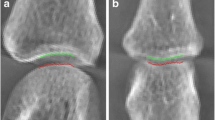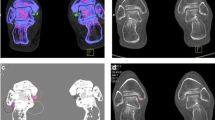Abstract
This aimed to compare the three radiographic methods of digital tomosynthesis (DT), plain radiography, and computed tomography (CT) for evaluating changes in feet of patients with chronic gouty arthritis. Two independent radiologists read the plain radiography, DT, and CT images of 30 male patients with gout. The degrees of erosion and joint space narrowing were scored using the Sharp–van der Heijde scoring method in 18 foot joints, which consisted of four proximal interphalangeal and one interphalangeal joint of the first toe, five metatarsophalangeal, five tarsometatarsal, and three naviculo-cuneiform joints of the foot. DT showed high reproducibility [0.929 for intraobserver intraclass correlation coefficient (ICC) and 0.838 for interobserver ICC]. DT showed similar results to those of CT and superior results to those of plain radiography for evaluating radiographic damage [mean total score, 8.5 ± 14.6 (±standard deviation) for plain radiography, 12.9 ± 12.4 for DT, and 12.6 ± 11.2 for CT]. This study showed that DT is a good method for evaluating radiographic changes in patients with gout. Further research is needed to apply DT to actual clinical settings.
Similar content being viewed by others
References
Choi HK, Mount DB, Reginato AM (2005) Pathogenesis of gout. Ann Intern Med 143:499–516
McQueen FM, Chhana A, Dalbeth N (2012) Mechanisms of joint damage in gout: evidence from cellular and imaging studies. Nat Rev Rheumatol 8:173–181
Dalbeth N, Collis J, Gregory K, Clark B, Robinson E, McQueen FM (2007) Tophaceous joint disease strongly predicts hand function in patients with gout. Rheumatology (Oxford) 46:1804–1807
Kavanaugh A, Han C, Bala M (2004) Functional status and radiographic joint damage are associated with health economic outcomes in patients with rheumatoid arthritis. J Rheumatol 31:849–855
Perez-Ruiz F, Martinez-Indart L, Carmona L, Herrero-Beites AM, Pijoan JI, Krishnan E (2014) Tophaceous gout and high level of hyperuricemia are both associated with increased risk of mortality in patients with gout. Ann Rheum Dis 73:177–182
Dalbeth N, Clark B, Gregory K, Gamble G, Sheehan T, Doyle A et al (2009) Mechanisms of bone erosion in gout: a quantitative analysis using plain radiography and computed tomography. Ann Rheum Dis 68:1290–1295
Ogdie A, Taylor WJ, Weatherall M, Fransen J, Jansen TL, Neogi T et al (2015) Imaging modalities for the classification of gout: systematic literature review and meta-analysis. Ann Rheum Dis 74:1868–1874
McQueen FM, Doyle A, Reeves Q, Gao A, Tsai A, Gamble GD et al (2014) Bone erosions in patients with chronic gouty arthropathy are associated with tophi but not bone oedema or synovitis: new insights from a 3 T MRI study. Rheumatology (Oxford) 53:95–103
McAdams HP, Samei E, Dobbins J 3rd, Tourassi GD, Ravin CE (2006) Recent advances in chest radiography. Radiology 241:663–683
Dobbins JT 3rd, Godfrey DJ (2003) Digital x-ray tomosynthesis: current state of the art and clinical potential. Phys Med Biol 48:R65–106
Canella C, Philippe P, Pansini V, Salleron J, Flipo RM, Cotten A (2011) Use of tomosynthesis for erosion evaluation in rheumatoid arthritic hands and wrists. Radiology 258:199–205
Aoki T, Fujii M, Yamashita Y, Takahashi H, Oki H, Hayashida Y et al (2014) Tomosynthesis of the wrist and hand in patients with rheumatoid arthritis: comparison with radiography and MRI. AJR Am J Roentgenol 202:386–390
Dalbeth N, Gao A, Roger M, Doyle AJ, McQueen FM (2014) Digital tomosynthesis for bone erosion scoring in gout: comparison with plain radiography and computed tomography. Rheumatology (Oxford) 53:1712–1713
Roddy E (2011) Revisiting the pathogenesis of podagra: why does gout target the foot? J Foot Ankle Res 4:13
Wallace SL, Robinson H, Masi AT, Decker JL, McCarty DJ, Yu TF (1977) Preliminary criteria for the classification of the acute arthritis of primary gout. Arthritis Rheum 20:895–900
van der Heijde D (1999) How to read radiographs according to the Sharp/van der Heijde method. J Rheumatol 26:743–745
Dalbeth N, Clark B, McQueen F, Doyle A, Taylor W (2007) Validation of a radiographic damage index in chronic gout. Arthritis Rheum 57:1067–1073
Shrout PE, Fleiss JL (1979) Intraclass correlations: uses in assessing rater reliability. Psychol Bull 86:420–428
Hallgren KA (2012) Computing inter-rater reliability for observational data: an overview and tutorial. Tutor Quant Methods Psychol 8:23–34
Zhu Y, Pandya BJ, Choi HK (2011) Prevalence of gout and hyperuricemia in the US general population: the National Health and nutrition examination survey 2007-2008. Arthritis Rheum 63:3136–3141
Simoni P, Gerard L, Kaiser MJ, Ribbens C, Rinkin C, Malaise O et al (2015) Use of tomosynthesis for detection of bone erosions of the foot in patients with established rheumatoid arthritis: comparison with radiography and CT. AJR Am J Roentgenol 205:364–370
Kim SK, Lee H, Kim JH, Park SH, Lee SK, Choe JY (2013) Potential interest of dual-energy computed tomography in gout: focus on anatomical distribution and clinical association. Rheumatology (Oxford) 52:402–403
Xia W, Yin XR, Wu JT, Wu HT (2013) Comparative study of DTS and CT in the skeletal trauma imaging diagnosis evaluation and radiation dose. Eur J Radiol 82:e76–e80
Son CN, Kim TE, Park K, Hwang JH, Kim SK (2016) Simplified radiographic damage index for affected joints in chronic gouty arthritis. J Korean Med Sci 31:435–442
Author information
Authors and Affiliations
Corresponding author
Ethics declarations
Ethics approval was obtained from the Institutional Review Board of Hanyang University Hospital for Rheumatic Diseases. Written informed consent was obtained from all participants and confirmed by the board.
Funding
This work was supported by the research fund of Hanyang University (HY-2014).
Disclosures
None.
Rights and permissions
About this article
Cite this article
Son, CN., Song, Y., Kim, SH. et al. Digital tomosynthesis as a new diagnostic tool for assessing of chronic gout arthritic feet and ankles: comparison of plain radiography and computed tomography. Clin Rheumatol 36, 2095–2100 (2017). https://doi.org/10.1007/s10067-017-3710-x
Received:
Revised:
Accepted:
Published:
Issue Date:
DOI: https://doi.org/10.1007/s10067-017-3710-x




